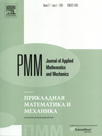 | | Journal of Applied
Mathematics and Mechanics
Russian Academy of Sciences | | Founded
in January 1936
(Translated from 1958)
Issued 6 times a year
ISSN 0021-8928
(print version) |
Archive of Issues
| Total articles in the database: | | 10482 |
| In Russian (ΟΜΜ): | | 9683
|
| In English (J. Appl. Math. Mech.): | | 799 |
|
| << Previous article | Volume 74, Issue 1 / 2010 | Next article >> |
| I.M. Anan'evskii, "Control of mechanical systems with uncertain parameters by means of small forces," J. Appl. Math. Mech. 74 (1), 95-107 (2010) |
| Year |
2010 |
Volume |
74 |
Issue |
1 |
Pages |
95-107 |
| Title |
Control of mechanical systems with uncertain parameters by means of small forces |
| Author(s) |
I.M. Anan'evskii (Moscow, Russia, anan@ipmnet.ru) |
| Abstract |
An approach to the construction of a feedback control for non-linear Lagrange mechanical systems with uncertain parameters is developed. A Lagrange mechanical system with uncertain parameters, which is subject to the action of potential forces, control forces and unknown perturbations is considered is considered. It is assumed that the potential forces can be considerably greater than the control forces which, in their turn, are greater than the perturbations. An approach to the construction of a control, is proposed which enables one to bring a system from an arbitrary initial state to a specified final state in a finite time using a bounded control. A procedure, in which the specified nominal trajectory of the motion is tracked, is used. Initially, the trajectory, joining the specified initial and final states of the system, is constructed for a certain dynamical system which is close to the initial system but with completely known parameters. Then, using deviation equations, a control is constructed which brings the initial system onto this nominal trajectory in a finite time and subsequently forces the system to move along this nominal trajectory up to the final state. The control law used in tracking the nominal trajectory is based on a linear feedback, the gains of which depends on the discrepancy between the real trajectory and the nominal trajectory. The gain increase and tend to infinity as the discrepancies tend to zero but the control forces remain bounded and satisfy the conditions imposed on them. The results of numerical modelling of the controlled motions of a plane double pendulum are presented as an illustration. |
| Received |
14 May 2009 |
| Link to Fulltext |
|
| << Previous article | Volume 74, Issue 1 / 2010 | Next article >> |
|
 If you find a misprint on a webpage, please help us correct it promptly - just highlight and press Ctrl+Enter If you find a misprint on a webpage, please help us correct it promptly - just highlight and press Ctrl+Enter
|
|

 Russian
Russian  English
English